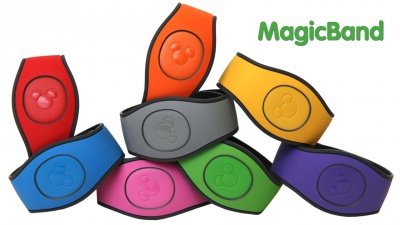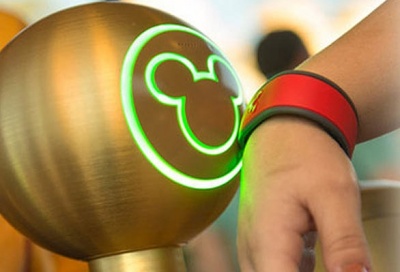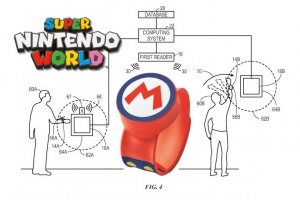MagicBands

MagicBands are wearable devices that are used in the Walt Disney World resorts & parks in Orlando, Florida. These devices collect data on guest behavior to simplify transactions and create individualized experiences for users. They were first implemented inside Disney parks in 2013 [2], and began being phased out in 2020 to shift their functionality to personal smartphones and begin testing facial recognition software for park entry. [3] [4] MagicBands function using RFID technology, which enables users to be identified from a distance [5] and powered by short and long range scanners throughout Disney property. [3] They are packaged in the form of a plastic bracelet in a wide array of colors and patterns with adjustable sizing for adults and children. While Disney is not the only amusement park using RF technology in this way, ethical concerns exist regarding Disney's data collection practices, targeted advertising, and information security with MagicBands, as well as Disney's potential shift from MagicBands to facial recognition technology in the parks.
Contents
History
Before the invention of MagicBands, guests entered the park with paper tickets and turnstiles and used in-park kiosks daily to retrieve paper fastpasses, and there was no central information source regarding wait times for attractions.[6] [7]
In 2013, the MyMagic+ suite of technology was phased into use in the Walt Disney World resorts & parks in Orlando, Florida with MagicBands at the forefront of this advancement. [8] With MagicBands, guests can unlock their resort hotel rooms, make Fastpass+ reservations in and outside of the parks, and buy food and merchandise [9]. The Magic Band syncs with users’ My Disney Experience App, displaying personalized experiences, ride photos available for purchase, reservations for fastpasses and dining.
This system was used in Orlando from summer 2013 until early 2020, when the COVID-19 pandemic caused Disney World to close for multiple months. When Disney World re-opened in July of 2020, many changes began to take place including mandatory mask-wearing, social distancing, limited capacity, pausing of the Fastpass+ service, and, later, the phasing out of MagicBands provided free of charge. [10] Beginning in 2021, MagicBands are no longer complimentary when a guest makes a reservation to stay at Disney World in Orlando. This is in preparation for a new update to the My Disney Experience app, which will shift all of the functionality of MagicBands to a user’s personal smartphone. [11]
The Technology of MagicBands
MagicBands are waterproof [12] bracelets, which contain active radio frequency technology (RFID) and a small transmitter which sends RF signals through a small antenna, which then sends and receives information through park servers.[13] [14] Short range touchpoints are used to verify admission and attraction reservations, and long range readers are used to provide information to parks to gather insights on guest behavior and deliver personalized experiences. [15] RFID technology does not contain any personal identifying information. Rather, each RFID tag contains a unique number that is transmitted to an encrypted database, which then can transmit a user’s personal information in response, but does not store it.[13] It has been used in car keys, medical bills, employee identification cards, and toll road tags. [16]
Ethical Concerns
Short-Range RFID: Park Entrance, Fastpass+, Purchases, and Hotels

Technology is used for extreme efficiency in the parks and resorts. When users touch the Mickey Mouse icon on their Magic Band to a matching Mickey Mouse icon on a short range touchpoint, they elicit a colorful reaction from the touchpoint to confirm the interaction - green for go, or blue for pause. [2] Similar to park entrance, guests touch their MagicBands to short-range touchpoints with Mickey Mouse icons to validate their Fastpass+ reservations. These reservations can be made before or after entering a park using the My Disney Experience app on a smartphone, and that data is shared with the RFID technology to use a Magic Band to validate a reservation. Guests can also use in-park kiosks to make Fastpass+ reservations. [18] For merchandise and casual dining purchases,MagicBands utilize short-range radio frequency readers, which access the credit card information optionally inputted by a guest to streamline the payment process [19] MagicBands are also used to unlock guests’ hotel doors if they stay at a resort on-property. [11] These features are not used by all guests because of the security risks associated with having personal information so readily available. [20]
Location Tracking: Personalized Dining & Lost Guests
MagicBands can use long range readers to track the locations of guests. This technology is utilized in Disney’s Be Our Guest restaurant to notify waitstaff of a guest’s arrival as well as their name and dinner order. Guests are greeted by name and then recieve their dinner orders after being seated without ever having to tell a waiter or waitress what they want. [2] MagicBands can also be used to track and locate guests who have lost their parties. [12]
Data Collection: My Disney Experience
The incorporation of all of these features in one wearable piece of technology results in a detailed collection of information about every guest, including their spending habits, eating habits, movement around the park, and interest in characters. [6] Disney claims to use this information to provide personalized experiences for their guests, including being greeted by name and sharing personal details like birthdays and anniversaries with employees for personal interactions. [21] Disney also uses this data to manage traffic flow around the park, as they can direct crowds and decrease congestion by sending characters to less popular areas. [12] Guests who opt into Disney’s Magical Express program use MagicBands before entering Disney property, as Disney-owned buses will pick up incoming guests from the Orlando Airport and automatically check them into their resorts using MagicBands. [12] While these features can be useful and enjoyable, some guests also express discomfort with the level of surveillance they and their children are under when they choose to use MagicBands. [6]
Less Invasive Options
Disney provides a less technologically advanced option for guests who are not interested in using MagicBands. Guests can instead receive a plastic card, much like an identification or credit card, that only uses passive RFID, which can only be used at a short range. This card will prevent Disney from collecting location data and sharing personal information with employees.
Furthermore, guests are not required to allow personalization functions during their stays. Guests can choose to withhold their names from employees and opt out of receiving special offers. [21] Disney CEO Bob Iger states that MyMagic+ is a completely optional program that was designed with privacy controls from the outset." [6]
Targeted Advertising
With the MagicBand, Disney is able to track customer purchases and therefore customer preferences. For example, if a MagicBand user uses their MagicBand to purchase 4 dolls from the movie Frozen, Disney knows that that user likes Frozen. They can then use this information to send targeted ads to that specific user in the future (such as Frozen shows specific to Walt Disney World or new Frozen merchandise).[22] With targeted advertising, Disney capitalizes on information that the MagicBand gathers on each user. Users consent to their information being utilized for advertising purposes by default when they choose to use a MagicBand, but can turn off personalization features later. Targeted advertising can be used while guests are in the park as well as after a Disney World trip in advertisements. [23]
Facial Recognition
In addition to Walt Disney World's shift from MagicBand to smartphone use for ticket and attraction validation, they are also testing the use of facial recognition software to be used for park admission. Disney World guests can opt into the test of facial recognition software for admission from March 23 to April 23, 2021. Guests under the age of 18 must receive parent or guardian permission to participate in the trial. Disney's facial recognition software converts a guest's face into an identifying number for park admission. Their software is being tested only with guests wearing face coverings and no other facial accessories such as sunglasses. [4] Facial recognition are controversial software, partially because of their history of inaccuracies with non-white faces.
Similar Technologies
Disney is not the only theme park that uses a wearable admission device.
TapuTapu
Universal Orlando's Volcano Bay, the water park at Universal Orlando, uses its own wearable device, the TapuTapu. The TapuTapu also utilizes active radiofrequency (RF) technology. It was designed, tested, and manufactured to comply with FCC regulations.[24] Much like Disney's MagicBand, Universal advertises this band as a way for customer's to personalize their experiences and no personal information is stored. Unlike the MagicBands, however, the device is not owned by the user and is returned upon exit from the park.
Very different from the MagicBands is the fact that the TapuTapu bands function mostly as a virtual queueing device. They do not allow access to hotel rooms and it is not associated with credit card information. The TapuTapu devices vibrate when it is your turn to ride. As soon as a guest leaves the park, any information collected is disassociated from that guest. [25]
Super Mario Power Up Bands

Universal Studios Japan will also be introducing a wearable device as part of the new Super Nintendo World expansion opening in 2021. This device will allow guests to interact with the land in various games and activities using, not only their arms, but their hands and entire bodies as well.[27] This device is an upcharge and can be linked to a smartphone app.[28] This band also uses RFID technology, but will be used more for integrating gaming into the land, than for admittance to the park or for making purchases. The primary use of these bands will be for guests to "punch" question blocks to redeem coins, similar to those found in the Super Mario games, play mini games around the land, and team up in "boss battles."[29]
References
- ↑ Smith, Thomas. "MagicBand2 Coming to Walt Disney World Resort." Disney Parks Blog. 19 November 2016. [1]
- ↑ 2.0 2.1 2.2 Kuang, Cliff. “Disney's $1 Billion Bet on a Magical Wristband.” Wired, Conde Nast. [2]
- ↑ 3.0 3.1 Magic Band Eligibility | FAQ [3]
- ↑ 4.0 4.1 Murphy Marcos, Coral. "Disney begins testing optional facial recognition for entry to Magic Kingdom". Detroit Free Press. 23 March 2021. [4]
- ↑ R. Want, "An introduction to RFID technology," in IEEE Pervasive Computing, vol. 5, no. 1, pp. 25-33, Jan.-March 2006, doi: 10.1109/MPRV.2006.2.
- ↑ 6.0 6.1 6.2 6.3 Perez, Chris. “Disney Uses Apps, 'MagicBands' to Track Guests: Report.” New York Post, New York Post, 24 July 2019. [5]
- ↑ Pugh, Jena. “FROM PAPER TO PAPERLESS: EVOLUTION OF DISNEY FASTPASSES.” Best of Orlando, 13 Feb. 2015. [6]
- ↑ Carr, Austin. “The Messy Business Of Reinventing Happiness.” Fast Company, Fast Company, 2 Dec. 2017. [7]
- ↑ What is a MagicBand? | FAQ [8]
- ↑ Pallotta, Frank. “Disney Parks Chief on Reopening: 'We Are in a New Normal'.” CNN, Cable News Network, 11 July 2020. [9]
- ↑ 11.0 11.1 MagicBands & Admission Cards [10]
- ↑ 12.0 12.1 12.2 12.3 Shamblin, Quinn R. “Disney Balances Convenience and Privacy.” CSO Online, CSO, 12 Jan. 2015. [11]
- ↑ 13.0 13.1 My Disney Experience – Frequently Asked Questions. (n.d.). Retrieved March 18, 2021, from https://disneyworld.disney.go.com/faq/my-disney-experience/frequency-technology/#:~:text=Each%20MagicBand%20contains%20an%20HF,throughout%20Walt%20Disney%20World%20Resort.
- ↑ Radio Frequency Technology | FAQ [12]
- ↑ Radio Frequency Technology | FAQ [13]
- ↑ Radio Frequency Identification (RFID): What is it? [14]
- ↑ Smith-Strickland, Kiona. "Disney Taps Contactless and NFC Technology as it seeks to Connect Customers to ITs Fantasy World." NFC Times. 18 Jan 2013. [15]
- ↑ What is Fastpass+ and How to Use It [16]
- ↑ My Disney Experience & MagicBands | FAQ [17]
- ↑ “Privacy Concerns Over Disney MagicBand.” Security Magazine RSS, Security Magazine, 1 Jan. 2014. [18]
- ↑ 21.0 21.1 Barnes, Brooks. “At Disney Parks, a Bracelet Meant to Build Loyalty (and Sales).” The New York Times, The New York Times, 7 Jan. 2013. [19]
- ↑ Borkowski, Stephen, et al. "MAGICBANDS IN THE MAGIC KINGDOM: CUSTOMER-CENTRIC INFORMATION TECHNOLOGY IMPLEMENTATION AT DISNEY." Journal of the International Academy for Case Studies 22.3 (2016): 143-51. ProQuest. Web. 18 Mar. 2021.
- ↑ The Current State of Advertising Ethics: Industry and Academic Perspectives Minette E. Drumwright &Patrick E. Murphy Pages 83-108 | Published online: 04 Mar 2013
- ↑ TapuTapu Wearable Technical Specifications. (n.d.). Retrieved March 18, 2021, from https://www.universalorlando.com/web/en/us/plan-your-visit/taputapu-faq
- ↑ Niles, R. (2017, February 9). Comparing Universal's TAPUTAPU Vs. Disney's MagicBands. Retrieved March 18, 2021, from https://www.themeparkinsider.com/flume/201702/5444/
- ↑ Stella, A. (2020, March 01). The tech behind super nintendo world's power up bands and interactive games. Retrieved March 18, 2021, from https://orlandoparkstop.com/news/theme-park-news/the-tech-behind-super-nintendo-worlds-power-up-bands-and-interactive-games/
- ↑ Mitchell, B. (2021, March 09). Super Nintendo World unveils Wearable wristbands. Retrieved March 18, 2021, from https://blooloop.com/theme-park/news/super-nintendo-world-wearable-wristband/
- ↑ Wang, S. (2021, March 18). Super Nintendo world opens in Osaka, Japan. Retrieved March 18, 2021, from https://www.cnn.com/travel/article/super-nintendo-world-universal-studios-osaka-japan-open/index.html
- ↑ Stella, A. (2020, March 01). The tech behind super nintendo world's power up bands and interactive games. Retrieved March 18, 2021, from https://orlandoparkstop.com/news/theme-park-news/the-tech-behind-super-nintendo-worlds-power-up-bands-and-interactive-games/